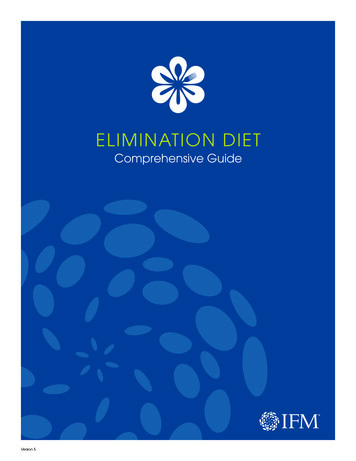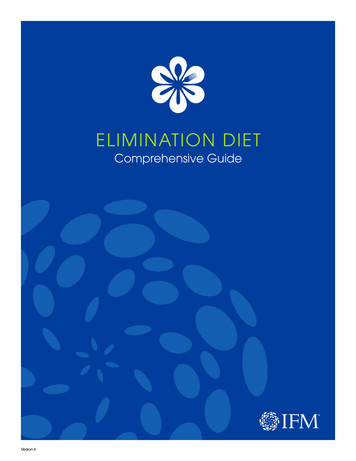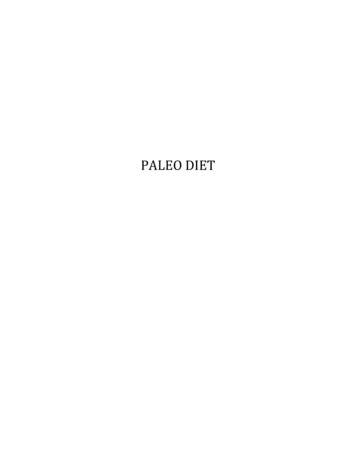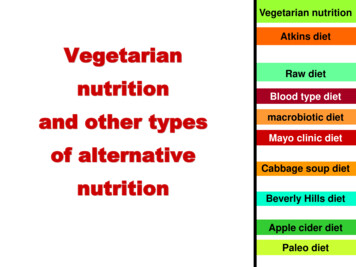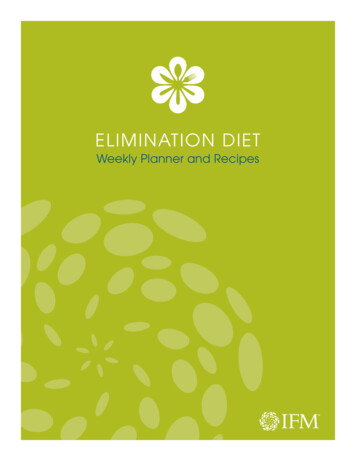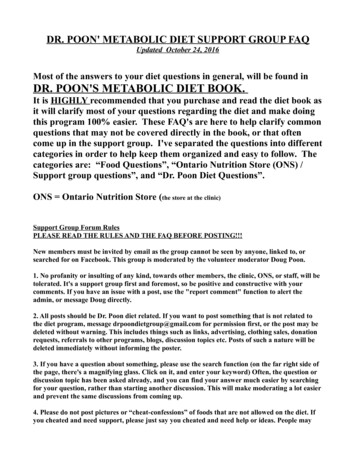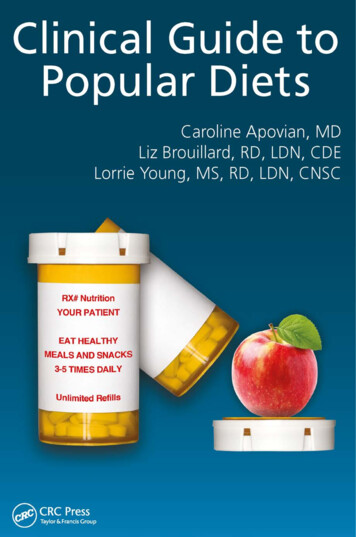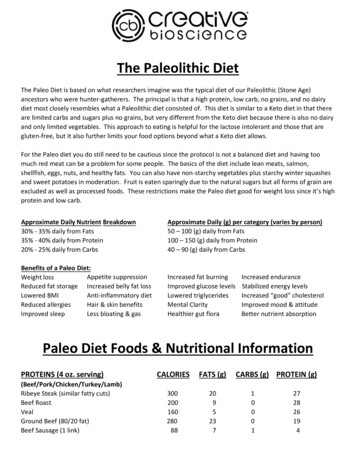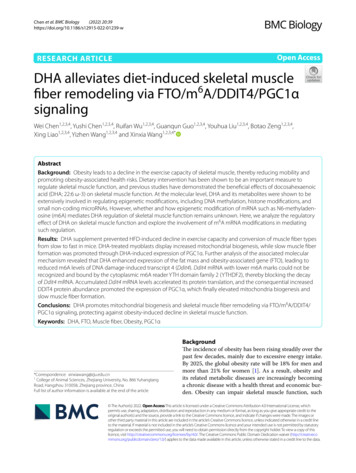
Transcription
Comprehensive Elimination DietLiz Lipski, PhD, tohealthexperts.comThe Comprehensive Elimination Diet is a dietary program designed to clearthe body of foods and chemicals to which you may be allergic or sensitive. Themain rationale behind the diet is that these modifications allow your body’sdetoxification machinery, which may be overburdened or compromised, torecover and begin to function efficiently again. The dietary changes help thebody eliminate or “clear” various toxins that may have accumulated due toenvironmental exposure, foods, beverages, drugs, alcohol or cigarette smoking. It also helps reduce inflammation throughout your body.This called an “Elimination Diet” because you remove certain foods andfood categories from your diet. During a period of two to three weeks, youeliminate the foods from your diet that are the most likely culprits of sensitivity symptoms. If your symptoms improve during the three-week period, you’llcarefully add foods back into your diet one at a time to see which foods may betriggering symptoms. Make sure to read all labels carefully to find hiddenallergens. Eat a wide variety of foods and do not try to restrict your calorieintake. If you find no improvement within three weeks either you do not haveany food allergies, or you may have food allergies but there is yet another factorcomplicating the picture. There are no magical answers here; this is a journeyof self-exploration and discovery.In my experience, I have found this process to be generally well toleratedand extremely beneficial. In fact, it’s the best clinical tool I know. There is reallyno “typical” or “normal” response. A person’s initial response to any new diet ishighly variable, and this diet is no exception. This can be attributed to physiological, mental and biochemical differences among individuals; the degree ofexposure to, and type of “toxin”; and other lifestyle factors. Most often, individuals on the elimination diet report increased energy, mental alertness,decrease in muscle or joint pain and a general sense of improved well-being.However, some people report some initial reactions to the diet, especially inthe first week, as their bodies adjust to a different dietary program. Symptomsyou may experience in the first week or so can include changes in sleep patterns, lightheadedness, headaches, joint or muscle stiffness and changes in gastrointestinal function. Such symptoms rarely last for more than a few days.
I realize that changing food habits can be a complex, difficult and sometimes confusing process. It doesn’t have to be, and I think that I have simplifiedthe process with diet menus, recipes, snack suggestions and other informationto make it a “do-able” process. Read this information carefully.Eat only the foods listed under “Foods to Include,” and avoid those foodsshown under “Foods to Exclude” in the “Comprehensive Elimination DietGuidelines.” These Guidelines are intended as a quick overview of the dietaryplan. If you have a question about a particular food, check to see if it is on thefood list. You should, of course, avoid any listed foods to which you know youare intolerant or allergic. We also may change some of these guidelines basedupon your personal health condition and history.Tips The first 2 to 3 days are the hardest. It’s important to go shopping toget all of the foods you are allowed to have. Plan your meals and have a pot of rice available. Eat simply. Cook simply. Make a pot of chicken-vegetable-rice soup.Make a large salad. Cook extra chicken. Have prepared food on handso you can grab something quickly. Eat regular meals. You may also want to snack to keep your blood sugar levels normal. Itis important to keep blood sugar stable. Carry food with you whenyou leave the house. That way you will have what you are allowed andnot be tempted to stray off the plan. It may be helpful to cook extra chicken, sweet potatoes, rice, beans,etc. that can be reheated for snacking or another meal. Avoid any foods that you know or believe you may be sensitive to,even if they are on the “allowed” list. Try to eat at least three servings of fresh vegetables each day. Chooseat least one serving of dark green or orange vegetables (carrot,broccoli, winter squash) and one raw vegetable each day. Vary yourselections. This is NOT a weight loss program. If you need to lose or gain weight,work with your practitioner on a program. Buy organic produce when possible. Select fresh foods whenever youcan. If possible, choose organically grown fruits and vegetables toeliminate pesticide and chemical residue consumption. Wash fruitsand vegetables thoroughly.
If you are a vegetarian, eliminate the meat and fish and consume morebeans and rice, quinoa, amaranth, teff, millet and buckwheat. If you are consuming coffee or other caffeine-containing beverages ona regular basis, it is always wise to slowly reduce your caffeine intakerather than abruptly stop it; this will prevent caffeine-withdrawalheadaches. For instance, try drinking half decaf/half regular coffee fora few days, then slowly reduce the total amount of coffee. Read oil labels; use only those that are obtained by a “cold pressed”method. If you select animal sources of protein, look for free-range or organically raised chicken, turkey or lamb. Trim visible fat and prepare bybroiling, baking, stewing, grilling or stir-frying. Cold-water fish (e.g.,salmon, mackerel, and halibut) is another excellent source of proteinand the omega-3 essential fatty acids, which are important nutrientsin this diet. Fish is used extensively. Remember to drink the recommended amount (at least two quarts)of plain, filtered water each day. Strenuous or prolonged exercise may be reduced during some or theentire program to allow the body to heal more effectively without theadditional burden imposed by exercise. Adequate rest and stressreduction are also important to the success of this program. You may use leftovers for the next days’ meals or part of a meal, e.g.leftover broiled salmon and broccoli from dinner as part of a largesalad for lunch the next day.POSSIBLE PROBLEMS: Most people feel better and better each day duringthe allergy elimination diet. However, if you are used to using caffeine, youmay get withdrawal symptoms the first few days which may include: headaches, fatigue irritability, malaise, or increased hunger. If you find your energylagging, you may need to eat frequently to keep your blood sugar levels (thinking, energy) level. Be sure to drink plenty of water.TESTING INDIVIDUAL FOODS: Once you have completed three weeksyou can begin to add foods back into your diet. KEEP A JOURNAL OF ALLFOODS EATEN AND ALL SYMPTOMS. Be sure to add foods one at a time,one every two days. Eat the test food at least twice a day and in a fairly largeamount. Often an offending food will provoke symptoms quickly—within in10 minutes to 12 hours. Signs to look for include: headache, itching, bloating,nausea, dizziness, fatigue, diarrhea, indigestion, anal itching, sleepy 30 minutes after a meal, flushing, rapid heartbeat. If you are unsure, take the foodback out of your diet for at least one week and try it again. Be sure to test foods
in a pure form: for example test milk or cheese or wheat, but not macaroni andcheese that contains milk, cheese and wheat!THE RESULTS: Avoiding symptom-provoking foods and taking supportive supplements to restore gut integrity can help most food allergies/sensitivities resolve within 4 to 6 months. This means that in most cases you will beable to again eat foods that formerly bothered you. In some cases, you will findthat the allergy doesn’t go away. In this case you must either wait longer or itmay be a “fixed” allergy that will be lifelong.AFTER THE TESTING: It would be advisable to return to your healthpractitioner for a follow-up visit to determine your next steps. If you find allergies to many foods, you may want to explore a 4-day food rotation diet.Finally, anytime you change your diet significantly, you may experiencesuch symptoms as fatigue, headache or muscle aches for a few days. Your bodyneeds time as it is “withdrawing” from the foods you eat on a daily basis. Yourbody may crave some foods it is used to consuming. Be patient! Those symptoms generally don’t last long, and most people feel much better over the nextcouple of weeks.Enjoy!COMPREHENSIVE ELIMINATION DIET GUIDELINESFoods to includeFoods to excludeFruits: whole fruits, unsweetened, frozen orwater-packed, canned fruits and dilutedjuicesOranges and orange juiceDairy substitutes: rice milkDairy and eggs: milk, cheese, eggs,cottage cheese, cream, yogurt, butter, icecream, frozen yogurt, non-dairycreamersGrains: wheat, corn, barley, spelt, kamut,Non-gluten grains and starch: rice (alltypes), millet, quinoa, amaranth, teff, tapioca, rye, triticale, oatbuckwheat, potato flourAnimal protein: fresh or water-packedcanned fish, wild game, lamb, duck, organicchicken and turkeyPork, beef/veal, sausage, cold cuts,canned meats, frankfurters, shellfishIF YOU ARE A VEGETARIAN:split peas, lentils and legumesIf you are not a vegetarian, do not includethese foods.Soybean products (soy sauce, soybean oilin processed foods, tempeh, tofu, soymilk, soy yogurt, textured vegetableprotein)
Foods to includeFoods to excludeNuts and seeds: Coconut, pine nuts, flaxseedsPeanuts and peanut butter, walnuts,sesame, pumpkin, and sunflower seeds,hazelnuts, pecans, almonds, cashews, nutbutters such as almond or tahiniVegetables: all raw, steamed, sautéed, juicedor roasted vegetablesCorn, creamed vegetables. If you havearthritis, avoid nightshades: tomatoes,potatoes, eggplants, peppers, paprika,salsa, chili peppers, cayenne, chili powderOils: cold-pressed olive, gheeButter, margarine, shortening, processedoils, salad dressings, mayonnaise, andspreads, flax, safflower, sesame, almond,sunflower, walnut, canola, pumpkinDrinks: filtered or distilled water,decaffeinated herbal teas, seltzer or mineralwaterAlcohol, coffee and other caffeinatedbeverages, soda pop or soft drinksSweeteners: Use Sparingly: brown ricesyrup, agave nectar, stevia, fruit sweetener,blackstrap molassesRefined sugar, white/brown sugars,honey, maple syrup, high fructose cornsyrup, evaporated cane juiceChocolate, ketchup, relish, chutney, soyCondiments: vinegar, all spices, includingsalt, pepper, basil, carob, cinnamon, cumin, sauce, barbecue sauce, teriyaki, and otherdill, garlic, ginger, mustard, oregano, parsley, condimentsrosemary, tarragon, thyme, turmericTHINGS TO WATCH FOR Corn starch in baking powder and any processed foods Corn syrup in beverages and processed foods Vinegar in ketchup, mayonnaise and mustard is usually from wheator corn Breads advertised as gluten-free which contain oats, spelt, kamut,rye Many amaranth and millet flake cereals have oats or corn Many canned tunas contain textured vegetable protein which isfrom soy; look for low-salt versions which tend to be pure tuna, with no fillers
READ ALL INGREDIENT LABELS CAREFULLYELIMINATION DIET SHOPPING LISTFruits Apples, applesauce Apricots (fresh) Bananas Blackberries Blueberries Cantaloupe Cherries Coconut Figs (fresh) Grapefruit Huckleberries Kiwi Kumquat Lemons and limes Loganberries Mangos Melons Mulberries Nectarines Papayas Peaches Pears Prunes Raspberries Strawberries All the above fruits canbe consumed raw or juicedVegetables Artichoke Asparagus Avocado Bamboo shoots Beets and beet tops Bok choy BroccoflowerVegetables cont. Broccoli Brussels sprouts Cabbage Bell peppers Carrots Cauliflower Celery Chives Cucumber Dandelion greens Eggplant Endive Kale Kohlrabi Leeks Lettuce – red or green leafand Chinese Mushroom Okra Onions Pak-Choi Parsley Potato Red leaf chicory Sea vegetables –seaweed, kelp Snow peas Spinach Squash Sweet potatoes and yams Swiss chard TomatoesVegetables cont. Watercress Zucchini All the abovevegetables can beconsumed raw,juiced steamed,sautéed or baked. Ifyou have arthritis,avoid nightshades(in italics).Animal Protein Free-rangechicken,turkey, duck Fresh oceanfish, e.g. Pacificsalmon, halibut,haddock, cod, sole,pollock, tuna,mahi-mahi Lamb Water-packedcannedtuna (watch foraddedprotein from soy) Wild gameOils Ghee Flax Olive Coconut
Herbs, Spices & Extracts Basil Black pepper Cinnamon Cumin Dandelion Dill Dry mustard Garlic Ginger Nutmeg Oregano Parsley Rosemary Salt-free herbal blends Sea salt Tarragon Thyme Turmeric Pure vanilla extractBreads & Baking Arrowroot Baking soda Gluten-free breads Flours: rice, teff, quinoa,millet, tapioca, amaranth, potato Mochi Rice bran Rice flour pancake mixRice tortillasNon-Gluten Grains Amaranth Millet Quinoa Rice – brown, white, wild Teff Buckwheat Rice crackersCereals & Pasta Cream of rice Puffed rice Puffed millet Quinoa flakes Rice pasta 100% buckwheat noodles Rice crackers/rice cakesDairy Substitutes Almond milk Rice milk Coconut milk Oat milkBeans: If you are vegetarian,include these foods. If you areeating animal foods, eliminatethese foods. All beans except soy Lentils - brown, green, red Split peas All the above beans can be driedor cannedNuts CoconutVinegars Apple cider Balsamic Red wine Rice Tarragon Ume PlumSweeteners Fruit sweetener(100% juiceconcentrate) Agave nectar Molasses Rice syrup SteviaCondiments Mustard (madewith apple cidervinegar)Beverages Herbal tea(non-caffeinated) Mineral water Pureunsweetened fruitorvegetable juicesSpring water
Menu IdeasHere are some ideas to stimulate your own creativity. Feel free to createyour own recipes and menus. Indicates that recipe follows.Breakfast: Feel free to add protein powder drinks, leftover chicken, fish,etc., to your breakfast menu. Cooked whole grain (oatmeal, cream of brown rice, buckwheat, teff,millet or quinoa) served with fresh or frozen fruit. Can add a bit ofcoconut, ghee, sweetener and/or cinnamon. To boost protein, haverice protein powder drink Home-fried potatoes: Cut onions, peppers, broccoli, mushrooms andother vegetables of your choice into small pieces and sauté in olive oilor ghee. Cut pre-baked potatoes into cubes and add to vegetables.Add salt/pepper/herbs/spices “Fried” rice: Use recipe above. Add rice instead of potatoes Toasted rice or lentil flax bread with coconut oil or ghee, 100% fruitjam or apple or pear butter, fresh fruit, and herbal tea Fruit smoothie: Blend rice milk with fruit. Possible choices: berries,bananas, pears, pineapple, mango, papaya, etc. Add flax seeds or psyllium seeds as desired. Add fish oil as desired. Drink on its own or aspart of a breakfast Rice pancakes topped with apple butter or apple sauce or sautéed apples Cold rice or amaranth or other gluten-free cereal (read label carefully)with fresh fruit (bananas, berries, pears, apples, etc) and rice milk Sweet potato delight , half a cantaloupe filled with blueberries or halfa papaya with lime juice Mochi rice waffles , topped with sautéed apples and fruit smoothiewith rice protein powder Breakfast rice pudding , rice milk, berriesLunch or Dinner: Large salad with grilled chicken or fish. Serve with non-glutencontaining bread or baked potato or winter squash or boiled newpotatoes Broiled salmon plus steamed or oven-roasted vegetables with cookedmillet or baked potato or sweet potato or quinoa salad. Can also adda salad with vinaigrette dressing
Asparagus soup (or other soup), cabbage salad , rice cakes withghee, fresh fruit Broiled lamb chop, green rice , cooked vegetables, fruity spinachsalad Fruit salad with coconut/or pine nuts. Serve with protein and ricecrackers Broiled or poached halibut, baked winter squash sprinkled with cinnamon and ghee, mixed green salad with vinaigrette dressing, mocharice squares and fruit for dessert Brown rice and grilled chicken, steamed greens, baked potato or sweetpotato Halibut salad: Mixed greens of your choice, leftover halibut cut intochunks, vinaigrette dressing. Serve with baked potato with ghee Chicken breast sprinkled with garlic powder and tarragon, steamedasparagus or broccoli, brown or wild rice or kasha, ghee or olive oil Quinoa with chicken-vegetable soup or vegetable soup Quinoa salad with leftover chicken or fish Chicken salad: leftover chicken, mixed greens, guacamole, millet withpine nuts Fresh tuna steak topped with herbs and broiled, rice pasta with oliveoil and mock pesto , steamed kale or collard greens tossed with oliveoil and garlic and vinegar, mixed green salad with vinaigrette dressing. Fruit for dessert Tuna salad: Canned tuna mixed with vinaigrette or eggless mayonnaise, baking powder biscuits , fresh fruit Roast turkey breast or broiled turkey burger, brown or wild rice, steamedvegetable, salad with vinaigrette. Baked apple or poached pear Turkey salad: leftover turkey breast, mixed greens, other fresh vegetables, lemon or oil and vinegar, rice crackers or baking soda biscuits ,fresh fruit or cup of soup Rice pasta primavera , pickled beets , mixed green salad with vinaigrette, leftover breakfast rice pudding topped with berriesSnacks: Rice cakes or crackers with ghee or unsweetened apple butter or coconut oil, raw carrot Guacamole on rice cakes Vegetables dipped into guacamole Baked apple Poached pear
Bowl of soup and rice crackersRice cakes or crackers spread with apple butterFresh fruitFresh vegetables: carrots, cucumbers, sweet peppers, etc.Mochi rice squares, plain or with apple butter or smashed berriesBaked sweet potatoesRecipesBreakfast:Breakfast Rice Pudding - Serves 41 cup uncooked short grain brown rice1¼ cups coconut milk1¼ cups water½ tsp. salt1 Tbsp. brown rice syrup1 tsp. cinnamonCombine water and coconut milk in heavy pot; bring to boil, adding rice andsalt. Simmer, covered (do NOT stir) for about 45 minutes or more, until liquidis mostly absorbed and rice is soft. Remove from heat and allow to cool for 15minutes. Stir in brown rice syrup and cinnamon.Mochi Rice Waffles - Serves 4Purchase 1 package of cinnamon-apple Mochi and defrost.Cut into quarters. Slice each quarter across to form 2 thinner squares.Place one square into preheated waffle iron and cook until done.Top with your choice of fruit or Sautéed Apples (below).Rice Pancakes - Makes approximately 14 (4-inch) pancakes.1 1/3 cups rice flour½ cup millet flour2 tsp. baking powder½ tsp. baking soda¼ tsp. salt1 Tbsp. apple butter1 Tbsp. gheeEgg Replacer to equal 2 eggs (Refer to recipe below.)1½ cups rice milk1½ Tbsp. apple cider vinegar
Mix the almond or rice milk with the vinegar and allow them to stand for 5minutes until curdles form. Mix dry ingredients together and set aside. In largemixing bowl, beat apple butter, oil, egg, and milk. Add dry mixture and stirgently. Be careful not to over-mix. Serve with Sautéed Apples (refer to recipebelow).Sweet Potato Delight - Serves 1-2Adapted and used with permission from The Allergy Self Help Cookbook, byMarjorie Hurt Jones, R.N. Rodale Press, Emmaus, PA.1 ripe banana1 medium sweet potato, cooked1 tsp. oil1 Tbsp. fruit sweetener, molasses or brown rice syrup (optional)Shake the pan often. Cut the banana in half lengthwise. Cut the cooked sweetpotato into ½” pieces. Add the oil to the pan. Place the banana pieces, flat sidesdown, in the pan. Add the sweet potatoes. Cover and cook for 2 minutes.Uncover, and cook for 5 minutes, until everything is heated through andbrowned on one side. Add the sweetener before serving.Lunch and Dinner:Oven Roasted Veggies – number of servings depend on amount of veggiesusedUse any combination of the following vegetables, unpeeled, washed, and cutinto bite-sized pieces: eggplant, small red potatoes, red onion, yellow or greensummer squash, mushrooms, asparagus. Toss with crushed garlic cloves, oliveoil and sprinkle with rosemary, oregano, tarragon, and basil to taste. Spread inroasting pan in single layers and roast approximately 20-25 minutes at 400degrees until veggies are tender and slightly brown, stirring occasionally. Theamount of time needed depends on the size of the veggie. Salt and pepper totaste. Serve while warm, or use cold leftovers in salad.Mock Pesto - Makes 1 cupUsed with permission from The Allergy Self Help Cookbook, by Marjorie HurtJones, R.N. Rodale Press, Emmaus, PA.1 large ripe avocado1 cup basil leaves¼ tsp. lemon juice1 garlic clove, minced or 1/8 tsp. garlic powder¼ cup pine nuts½ tsp. olive or flax oil
Cut the avocado in half and remove the pit. Scoop out the flesh and place it ina bowl of a food processor. Add the basil, vitamin C crystals, garlic and pinenuts. Process for about 2 minutes – scrape the bowl as necessary. Transfer it toa small bowl and coat the surface with oil to prevent browning. Chill.Rice Pasta Primavera – Serves 42 cups uncooked rice pasta (noodles, spaghetti, elbows)1 large whole chicken breast, cut into thin strips (optional)Broccoli florets, chopped carrot, and/or other favorite veggie, lightly steamed3-4 scallions, chopped2 cloves garlic, minced1 Tbsp. olive oil (more if needed)¼ cup fresh basil, finely chopped¼ - ½ cup coconut milkCook rice pasta according to package directions. While pasta is cooking, heatoil in wok or heavy frying pan, and stir fry chicken strips or tofu chunks, garlic,scallions, and basil for about 5 minutes; add remaining vegetables and coconutmilk and continue to cook until veggies are soft and glisten. Add more coconutmilk as needed. Remove from heat and spoon over drained rice pasta andgarnish with black olives and extra olive oil, if desired.Soups and Stocks:Asparagus Soup - Serves 4Used with permission from The Allergy Self Help Cookbook, by Marjorie HurtJones, R.N. Rodale Press, Emmaus, PA.1 lb. asparagus, trimmed2 medium leeks or 4 large shallots1 Tbsp. oil2-3 cloves garlic, minced2 cups water or chicken stock1 tsp. dried dill weedpinch nutmegSlice off the tips of the asparagus and reserve them. Cut the remaining stalksinto 1” pieces. Slice the leeks in half lengthwise and wash under cold water toremove any sand. Slice into ¼” pieces. Sautée the leeks or shallots in the oilover medium heat until soft. Add the garlic and sliced asparagus stalks.Cook, stirring, another minute or two. Add the water or stock and dill. Simmer10-12 minutes.Remove from heat, allow to cool 5-10 minutes. Puree half the volume at a time.Return to pan, add the reserved asparagus tips and simmer 3-5 minutes or
until tips are just barely tender. Add nutmeg. If soup is too thick, thin withadditional water or stockBasic Stock RecipeIn a stock pot:Put 2 pounds bones, skin, cartilage from poultry, fish, beef, lamb, shellfish.(If you use a whole chicken, cook for about an hour, then take meat off thebones. Toss bones and connective tissue back into the pot. Leave the meataside.)Cover with water (2-3 quarts)1-2 Tbsp. of lemon juice or vinegar1-2 tsp salt½ tsp pepperCarrots, onions, celeryParsley, sage, rosemary, thyme, bayCook several hours (4-24) or in crock pot on low temp.Skim off scum/solids from top of soup after a couple of hours.Remove bones. Skim off fat. (Sometimes it’s easiest to refrigerate and thenskim off fat.)Either strain and use as broth, or begin adding vegetables, grains, etc., to makea soup. Can be used to cook grains or vegetables instead of water.Beef StockRecipe courtesy of Sally Fallon, Nourishing Traditionsabout 4 pounds beef marrow and knuckle bones1 calf ’s foot, cut into pieces (optional)3 pounds meaty rib or neck bones4 or more quarts cold filtered water1/2 cup vinegar3 onions, coarsely chopped3 carrots, coarsely chopped3 celery stalks, coarsely choppedseveral sprigs of fresh thyme, tied together1 teaspoon dried green peppercorns, crushedl bunch parsleyPlace the knuckle and marrow bones and optional calf ’s foot in a very large potwith vinegar and cover with water. Let stand for one hour. Meanwhile, placethe meaty bones in a roasting pan and brown at 350 degrees in the oven. Whenwell browned, add to the pot along with the vegetables. Pour the fat out ofthe roasting pan, add cold water to the pan, set over a high flame and bring
to a boil, stirring with a wooden spoon to loosen up coagulated juices. Addthis liquid to the pot. Add additional water, if necessary, to cover the bones;but the liquid should come no higher than within one inch of the rim of thepot, as the volume expands slightly during cooking. Bring to a boil. A largeamount of scum will come to the top, and it is important to remove this with aspoon. After you have skimmed, reduce heat and add the thyme and crushedpeppercorns.Simmer stock for at least 12 and as long as 72 hours. Just before finishing, addthe parsley and simmer another 10 minutes. You will now have a pot of ratherrepulsive-looking brown liquid containing globs of gelatinous and fatty material. It doesn’t even smell particularly good. But don’t despair. After strainingyou will have a delicious and nourishing clear broth that forms the basis formany other recipes in this book.Remove bones with tongs or a slotted spoon. Strain the stock into a large bowl.Let cool in the refrigerator and remove the congealed fat that rises to the top.Transfer to smaller containers and to the freezer for long-term storage.Salads and Vegetables:Cabbage Salad - Serves 4-61 small to medium head red cabbage, thinly sliced (or use half red and halfgreen cabbage)8 sliced radishes, or 1 grated carrot3 green apples, diced1 stalk celery, choppeddash garlic powder2 Tbsp. olive oil2 tsp. vinegar1 tsp. lemon juiceMix all ingredients in a bowl and allow to sit for an hour, stirring once or twice.Serve cold or at room temperature.Fruity Spinach Salad - Serves 6-81 lb. fresh spinach, washed, dried, torn into pieces1 pint fresh organic strawberries or raspberries, washedDressing:3 Tbsp pine nuts2 scallions, chopped½ cup olive or flax oil¼ cup balsamic vinegar
Cut berries in half and arrange over spinach in serving bowl. Combine dressing ingredients in blender or food processor and process until smooth. Justbefore serving, pour over salad and toss. Garnish with nuts.Guacamole - Makes 1 ½ - 2 cupsUsed with permission from The Allergy Self Help Cookbook, by Marjorie HurtJones, R.N. Rodale Press, Emmaus, PA.2-3 ripe avocados¼ cup chopped onions¼ tsp. vitamin C crystals1 Tbsp. water1 small clove garlic, choppedCut the avocados in half, remove the pits, then scoop the flesh into a blenderor food processor. Add the onions, vitamin C crystals, water, and garlic. Processuntil smooth. Transfer to a small bowl. Cover and chill. Use within 2-3 days. Toprevent darkening, coat top with a thin layer of oil. For a chunky version, mashthe avocado with a fork and finely chop onions and garlic.Pickled Beets - Serves 4-6Adapted with permission from The Allergy Self Help Cookbook, by MarjorieHurt Jones, R.N. Rodale Press, Emmaus, PA.4 beets, cooked and skinned¼ cup water1 Tbsp. brown rice syrup or fruit sweetener¼ cup rice vinegar¼ tsp. ground cinnamonpinch each of cloves and allspiceCombine the water, sweetener, vinegar, cinnamon, cloves and allspice in amedium saucepan. Simmer for 2 minutes. Stir in the beets, and heat through.Serve hot or warm.Quinoa Salad - Serves 8-101 ½ cups quinoa, rinsed several times3 cups water, or chicken broth or vegetable broth (or a combination)1 cup fresh or frozen peas (frozen baby peas should be just defrosted)Chopped veggies, raw or lightly steamed (broccoli, asparagus, green beans,etc)½ cup chopped red onion1 pint cherry tomatoes (optional)½ cup chopped black olives (optional)
1/3 cup olive oil2 Tbsp. balsamic vinegar or lemon juice1 or 2 crushed garlic cloves2-4 Tbsp. fresh dill, chopped (or 1 Tbsp. dried dill)2 Tbsp. chopped fresh parsleysalt and pepper to tasteRinse quinoa well (quinoa tastes bitter if not well rinsed). Bring 3 cups wateror broth to a boil. Add rinsed quinoa and bring back to boil. Simmer uncovered for about 15 minutes until liquid is well absorbed. Transfer to large bowlwith a small amount of olive oil to prevent sticking, and allow to cool.Meantime, mix together remaining oil, vinegar or lemon juice, parsley, andgarlic in a small bowl. Add veggies to quinoa and toss well with dressing mixture, dill, salt and pepper. Chill before serving.Vinaigrette Dressing - 6 servings (approximately)Note: ingredient amounts in this recipe are approximate; use more or less of certain ingredients to adapt recipe to your personal taste.½ cup extra-virgin olive oil3 Tbsp. balsamic vinegar (preferred because it has the richest flavor)2-3 Tbsp. water1 tsp. dry mustard1-3 cloves fresh garlic (whole pieces for flavor or crushed for stronger taste)Salt and pepper to tasteOregano, basil, parsley, tarragon or any herbs of your choice, fresh or driedPlace vinegar, water and mustard in a tightly capped jar, and shake well tothoroughly dissolve mustard. Add oil and remaining ingredients and shakewell again. Store refrigerated and shake well before using. Dressing will hardenwhen cold; allow 5-10 minutes to re-liquify.Grains/BreadsBasic Kasha - Serves 4-51 cup buckwheat groats2 cups water, chicken or vegetable brothRoast the dry buckwheat groats over medium heat in a dry skillet, stirringuntil the grains begin to smell toasty, about 2 minutes. Add the water or broth,cover and simmer for 20-30 minutes, until kasha is tender but not mushy. Pouroff any excess liquid.Optional: add onion, garlic and herbs to the dish.
Baking Powder Biscuits - Makes one dozen1½ cups brown rice flour½ cup tapioca flour4 tsp. baking powder1/8 tsp. salt3 Tbsp. ghee1 cup applesauce, unsweetenedPreheat oven to 425 degrees. In a medium-large mixing bowl, stir together dryingredients. Sprinkle oil on top and mix well with a pastry blender or fork,until consistency is crumbly. Mix in applesauce and stir until blended. Spoonheaping tablespoonfuls onto ungreased cookie sheet. With spoon, lightly shapeinto biscui
Comprehensive Elimination Diet Liz Lipski, PhD, CCN828-645-7224 www.innovativehealing.com www.accesstohealthexperts.com Th e Comprehensive Elimination Diet is a dietary program designed to clear the body of foods and chemicals to which you may be allergic or sensitive. Th e main rationale behind the
